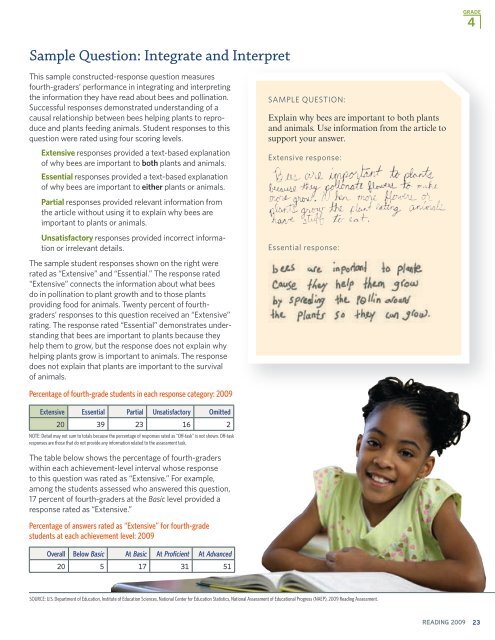Reading 2009 - African American Communication and Collaboration ...
Reading 2009 - African American Communication and Collaboration ...
Reading 2009 - African American Communication and Collaboration ...
You also want an ePaper? Increase the reach of your titles
YUMPU automatically turns print PDFs into web optimized ePapers that Google loves.
GRADE<br />
4<br />
Sample Question: Integrate <strong>and</strong> Interpret<br />
This sample constructed-response question measures<br />
fourth-graders’ performance in integrating <strong>and</strong> interpreting<br />
the information they have read about bees <strong>and</strong> pollination.<br />
Successful responses demonstrated underst<strong>and</strong>ing of a<br />
causal relationship between bees helping plants to reproduce<br />
<strong>and</strong> plants feeding animals. Student responses to this<br />
question were rated using four scoring levels.<br />
Extensive responses provided a text-based explanation<br />
of why bees are important to both plants <strong>and</strong> animals.<br />
Essential responses provided a text-based explanation<br />
of why bees are important to either plants or animals.<br />
Partial responses provided relevant information from<br />
the article without using it to explain why bees are<br />
important to plants or animals.<br />
Unsatisfactory responses provided incorrect information<br />
or irrelevant details.<br />
The sample student responses shown on the right were<br />
rated as “Extensive” <strong>and</strong> “Essential.” The response rated<br />
“Extensive” connects the information about what bees<br />
do in pollination to plant growth <strong>and</strong> to those plants<br />
providing food for animals. Twenty percent of fourthgraders’<br />
responses to this question received an “Extensive”<br />
rating. The response rated “Essential” demonstrates underst<strong>and</strong>ing<br />
that bees are important to plants because they<br />
help them to grow, but the response does not explain why<br />
helping plants grow is important to animals. The response<br />
does not explain that plants are important to the survival<br />
of animals.<br />
SAMPLE QUESTION:<br />
Explain why bees are important to both plants<br />
<strong>and</strong> animals. Use information from the article to<br />
support your answer.<br />
Extensive response:<br />
Essential response:<br />
Percentage of fourth-grade students in each response category: <strong>2009</strong><br />
Extensive Essential Partial Unsatisfactory Omitted<br />
20 39 23 16 2<br />
NOTE: Detail may not sum to totals because the percentage of responses rated as “Off-task” is not shown. Off-task<br />
responses are those that do not provide any information related to the assessment task.<br />
The table below shows the percentage of fourth-graders<br />
within each achievement-level interval whose response<br />
to this question was rated as “Extensive.” For example,<br />
among the students assessed who answered this question,<br />
17 percent of fourth-graders at the Basic level provided a<br />
response rated as “Extensive.”<br />
Percentage of answers rated as “Extensive” for fourth-grade<br />
students at each achievement level: <strong>2009</strong><br />
Overall Below Basic At Basic At Proficient At Advanced<br />
20 5 17 31 51<br />
SOURCE: U.S. Department of Education, Institute of Education Sciences, National Center for Education Statistics, National Assessment of Educational Progress (NAEP), <strong>2009</strong> <strong>Reading</strong> Assessment.<br />
READING <strong>2009</strong><br />
23


